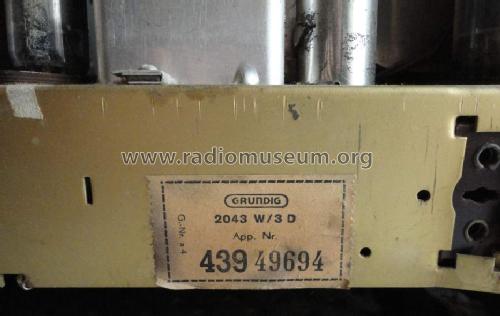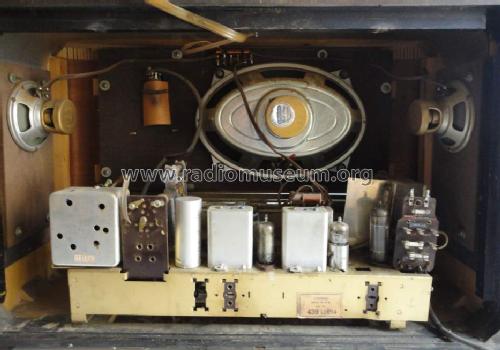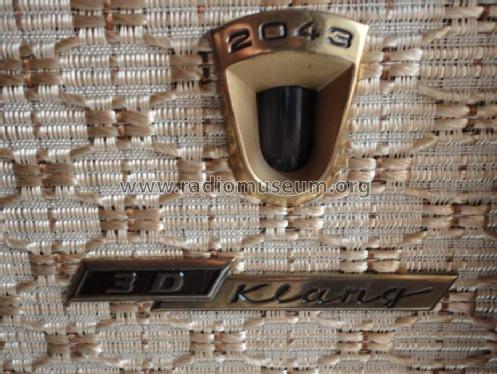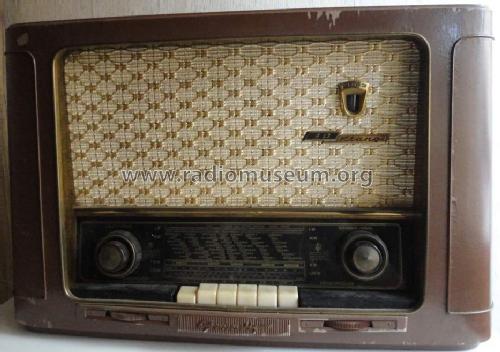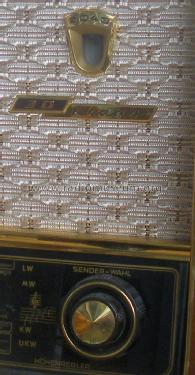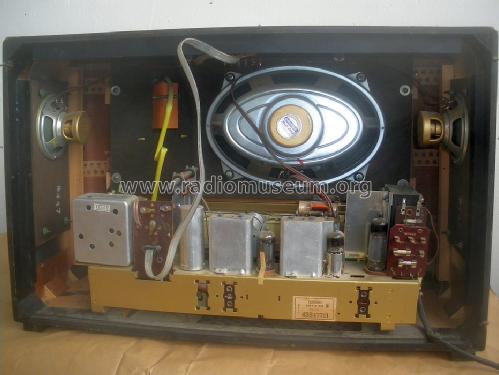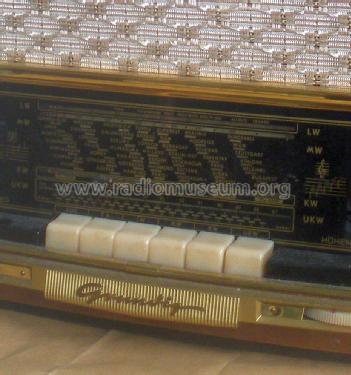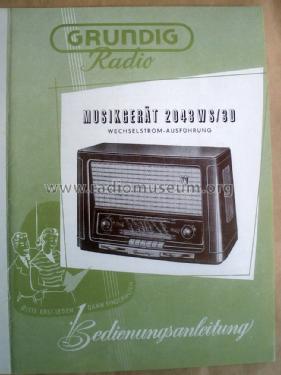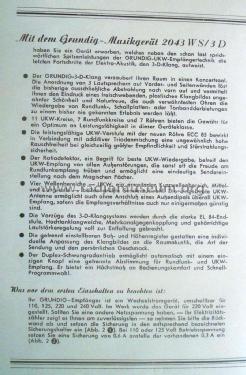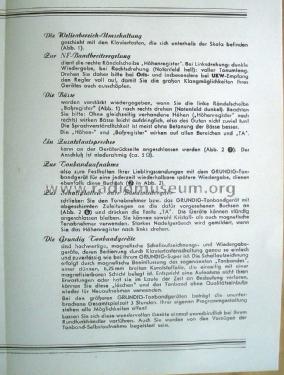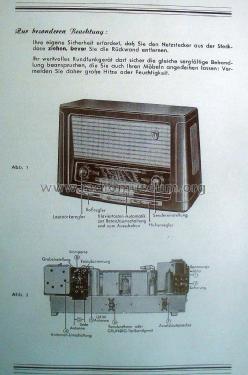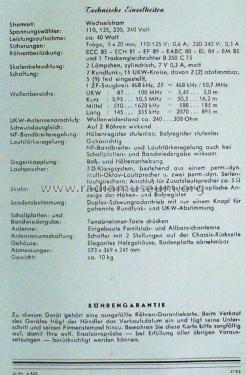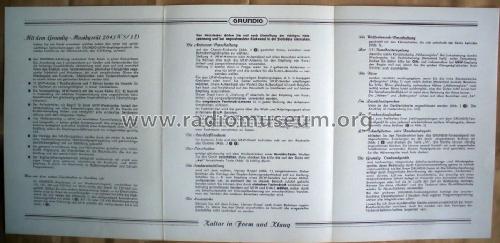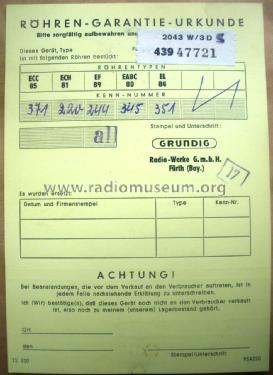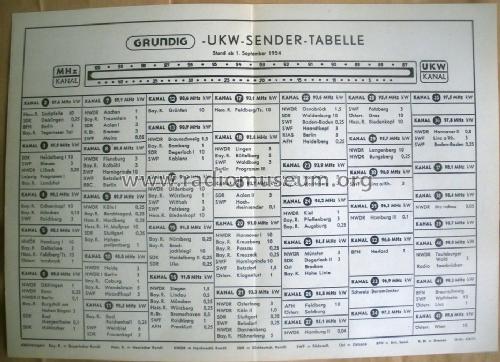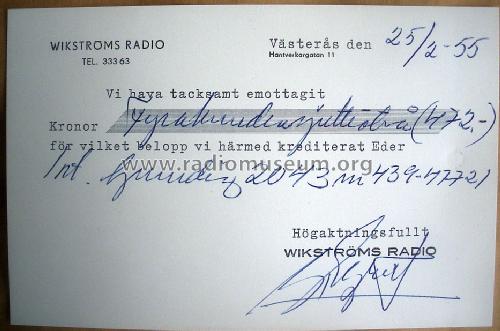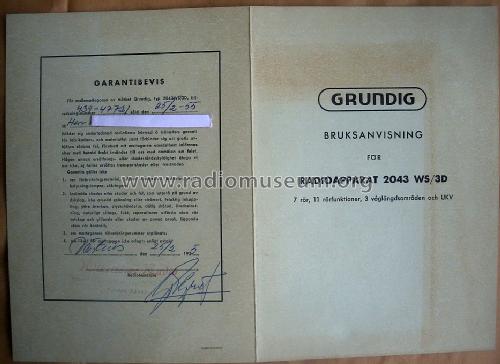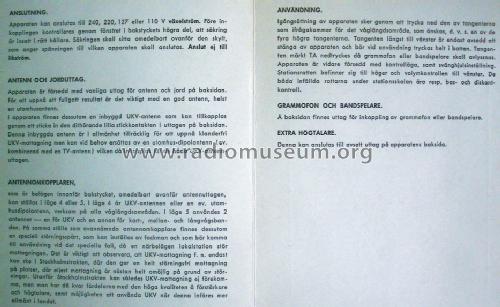- Country
- Germany
- Manufacturer / Brand
- Grundig (Radio-Vertrieb, RVF, Radiowerke)
- Year
- 1954/1955

- Category
- Broadcast Receiver - or past WW2 Tuner
- Radiomuseum.org ID
- 222982
-
- alternative name: Grundig Portugal || Grundig USA / Lextronix
- Number of Tubes
- 6
- Main principle
- Superheterodyne (common); ZF/IF 468/10700 kHz; Export model
- Tuned circuits
- 7 AM circuit(s) 11 FM circuit(s)
- Wave bands
- Broadcast, Long Wave, Short Wave plus FM or UHF.
- Power type and voltage
- Alternating Current supply (AC) / 110; 125; 220; 240 Volt
- Loudspeaker
- 3 Loudspeakers
- Power out
- 5 W (unknown quality)
- Material
- Wooden case
- from Radiomuseum.org
- Model: 2043WS/3D - Grundig Radio-Vertrieb, RVF,
- Shape
- Tablemodel with Push Buttons.
- Dimensions (WHD)
- 573 x 369 x 241 mm / 22.6 x 14.5 x 9.5 inch
- Notes
-
Grundig 2043WS/3D ist ein Exportmodell für Schweden und weist zumindest einen kleinen Unterschied zum Modell 2043W/3D auf: "WS" hat die Spannung 240 statt 160 Volt anzubieten. Das Modell 2043W/3D gibt es in mehreren Versionen: Die Versionen 1, 2, und 3 (sch2) haben einen FM-HF-Teil in Normalschaltung. Das AM-Teil hat 6 Kreise. - - Die Version 4 (sch1) hat im FM-HF-Teil eine ZF Reflexstufe (ECC85 + 2 Kreise mehr) und im AM-Teil ein dreikreisiges Diodenfilter (1 Kreis mehr). Der Innenansicht nach trifft das auch für dieses Exportmodell zu.
Siehe auch die anderen Modelle aus der 2043er Reihe - wie: 2043GW mit UC92, 2043GW mit UCC85, 2043W mit EC92, 2043W mit ECC85 und Musikschrank 7015 mit diesem Chassis, sowie die Export-Modelle 7015USA, 7015WE und SEMKO 7015S.
- Net weight (2.2 lb = 1 kg)
- 11 kg / 24 lb 3.7 oz (24.229 lb)
- External source of data
- Guest Martti L., Västerås, Sweden
- Author
- Model page created by Ernst Erb. See "Data change" for further contributors.
- Other Models
-
Here you find 6196 models, 5420 with images and 4190 with schematics for wireless sets etc. In French: TSF for Télégraphie sans fil.
All listed radios etc. from Grundig (Radio-Vertrieb, RVF, Radiowerke)
Collections
The model is part of the collections of the following members.
Forum contributions about this model: Grundig Radio-: 2043WS/3D
Threads: 1 | Posts: 1
The usual Grundig domestic suffixes
On many Grundig models you find a suffix. The most used domestic suffix is W for AC current (in German "Wechselstrom"), followed by GW for AC/DC models (Gleichstrom/Wechselstrom). Some "B" for battery models are found. BGW would be a "three current" model for AC/DC or battery operation. Z stands for a vibrator (Zerhacker) for operation with a storage battery.
"H" could be wood and "P" plastic cabinet. Certain consoles carry "ML". PM?
You can find GW/U, W/UKW etc. for models with FM. Some models carry GWL, WL or GWK or WK, where "L" stands for long waves instead of "K" for short waves (Kurzwellen). Seldom you find an "F" for "Ferrit-Antenna", "Ph" (or PM = Philips Mignon) for a phono model or a "TB" for a built in tape recorder. ST for a separate stereo loudspeaker.
Specially in 1954 Grundig named their models .../3D, indicating a stereo sound with additional loudspeakers on the two sides. "a" is a changaed version.
Here we try to bring in data for the export suffixes
Grundig exports in the 1950s and 1960s were tremendous and models were exported into different countries with different safety regulations. This was not only a matter for a solid back wall but also for fuses - for instance on both sides, line and neutral, but also that there was not a danger that sets could produce a fire.
Different countries used and use different voltages - or different cycles, for instance 25 or 60 in America and 50 in Europe. Japan uses 100 volts, not 110 to 125. In italy 160 Volts were also used, but at the same time 240 Volts in Scandinavia and the UK.
During about 50 years those regulations changed in different times and different countries!
Even the very strong regulations in Scandinavia could be different in Norway, Sweden, Danmark or Finland.
Most often the scale was naturally different for expor models.
To my knowledge the distinction for export began with a simple "WE" for export models, for instance in 1953 for the 5050WE.
The suffix USA is clear (used was also U and US) - and the sets often are called Grundig-Majestic.The big problem for collectors is now that such detailed plans for the power section of export models are rare because in Germany only the designing engineer became 2 blueprints and the prints were shipped abroad with a plan - which was often lost. Some plans we can find in Photofacts - see the Schematic Finder. What we could upload can be found on the specific model page.
See here also the suffix "GB" for the UK and what is different: Grundig 3028/GB.
CA stands for Canada - see SO102/60CA.
We are not sure if the suffix S stands for Scandinavia or for Sweden, but that it belongs to one of the two. Here is an early one - most information on the back panel still in German (1954), some in Swedish: 941WS. Here in Swedish: 4088/S. Later SEMKO was the Swedish partner.
You can also find CA/S as suffix - for Canada and Sweden or Scandinavia.
We try here to bring in facts where we are sure about them. Our member, Hans M. Knoll, a former designing engineer at Grundig for many years, told me for instance that the model Grundig 2043WS-3D in comparison with Grundig 2043W-3D has 3 fuses more, a two pole line switch and one can see on the voltage selection plate two normal fuses and one thermo fuse. A third glass type fuse is below the chassis in the main heater cable.
There are also suffixes like WE, WEM, WFE, WX, WZ, WI or W/EI (for instance for France or Italy - maybe this is a I and not a J) etc. Here for Italy: 955WI/3D and 955W/3D-EF/Ph/J or I ...
"F" stands for Ferrit antenna or turnable Ferrit antenna - see top in this article.
See also this 4088EES. And if the Civil Defense marks (CD) are found on this 970EES and EES-V, then not only U, US or USA was used for export to the USA but also EES.
I believe that X stands for tropical version. See Grundig model 2045WZX.
Ernst Erb, 30.Aug.12

